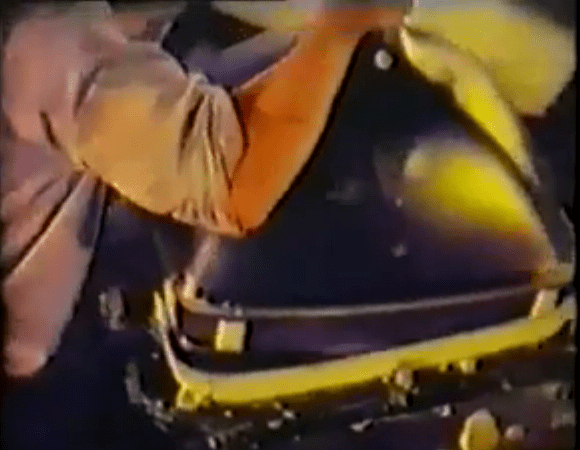This week we return to the grainy and un-color-corrected goodness that is synonymous with ancient video reels. [CNK] sent in a tip to a set of videos showing how Cathode Ray Tubes are manufactured on a massive scale. You’ll want to watch the pair of clips embedded below which total about 18 minutes. But there’s also some background to be found at this post from the Obsolete Technology Telley Web Museum.
The video presentation starts off with a brief overview of the way a color CRT works. It then moves to a factory tour, carefully showing each step in the process. The footage was shot in the 1960’s and because of that we catch a glimpse of some vintage equipment, like that used to measure the curvature of the CRT glass. You may be thinking that the world of CRT is in the past, but not so. We think there may even been a coming fad of producing them in your home lab.
Retrotechtacular is a weekly column featuring hacks, technology, and kitsch from ages of yore. Help keep it fresh by sending in your ideas for future installments.















Incredible.
I’m 53 yrs old and in electronics most of my life. Still, I learned something from this video that I’ve never known. The 3 phosphor stages … amazing. I love these Retrotechtacular videos that HAD has been posting! Keep em coming!
Exactly my thoughts. I have always wondered how the three phosphor matrix was done. Brilliant!
+1 as well. I always ASSumed that it was done in lines (using some microscopic Icing Bag like contraption), but the way that it is done makes so much more sense.
Between the current public stoning of the CRT as an overweight eyesore and its eventual resurrection as near-magical curiosity (just like any other vacuum tube), we’re rapidly losing both expertise and tools. The Early TV Museum is trying to safeguard both: http://www.earlytelevision.org/crt_project.html
Actually Arcade enthusiast are still into CRTs. I am waiting for the Hipster TV crowd to start claiming that analog is the only way to watch tv.
People into “retro gaming” already do this. They’re right in that differences in pixel shape, dot pitch, etc between CRTs and modern screens change how the game looks, sometimes radically.
Thing is, since the modern screens are sharper and higher resolution, you can usually compensate for the differences via post processing. That the emulators capable of this aren’t usually accurate enough to really match the original experience is a separate problem.
Of course, there really isn’t a good or easy way to get old lightgun games to work with non-CRTs.
I was just thinking, “I wonder when videophiles will start saying they look “warmer” than LCD’s” or something.
I prefer CRTs for fast shooters like Q3A, QL and warsow, since some cheap consumer TFTs have considerable lag (50ms or worse). So why should I buy a cheap 20” TFT if I can get a 21” CRT with 1600×1200 @ 100Hz for 20€? And my CRT was once really expensive and it doesn’t cause eyestrain and I really like it’s warmth in the winter
Such a pity good quality digital multisyncs are as dead as the dodo.
I don’t know – the CRT’s were heavy and NTSC wasn’t exactly a premium.
That said – there aren’t any CRT’s in this house anymore. Wait, there’s the one in my Tek scope but that doesn’t count.
Retrotechtacular is my favourite feature on hackaday, keep ’em coming! Also linked in the video after was a really good video on vacuum tubes: http://www.youtube.com/watch?feature=player_embedded&v=S6IeuC8DSvg
this is worth a look too
http://www.youtube.com/watch?v=QEi1ggtO5Oc
60 second mark. Love the casual approach
I don’t even have to look at it again to know what moment you are talkin about. So smooth.
Didn’t know they could quickly and easily hand assemble the electron gun assembly. Filaments, cathodes, and grids all put together like it’s regular LEGO parts. Of course robots weren’t around back then that was capable of precision assembly.
I still have a CRT. I have a very small portable TV just for cool factor: i256.photobucket.com/albums/hh198/puddle_jump/big_screen_zps554946a3.png The screen is so small a single US coin almost complete covers it. I also have a Commodore monitor simply because everything seems to look better than any 4:3 LCD could be.
I wonder if any of the CRT factories ever made to sell “blank” CRT that has no phosphor and lead coating so it’d be completely clear and be able to see the gut inside.
Kids today will never know how frustrating it was when you continually had to get up to adjust the vertical hold. Nor how often you’d pull out a handful of tubes and take them to a tube checker in the hopes you could fix some weird problem with the picture. Oh, and don’t forget screwing with the antenna. Some days, you just weren’t going to get to watch that show you’d been waiting for.
Three CRT-based TVs here-The last of them just seem to last forever…
All my CRT computer monitors are in the closet… But I’ve still got a 25″ CRT in my NEO-GEO MVS standup cab, you betcha! Be nice to have a Japanese cab too though, with one of those 29″ multisyncs…
This certainly was a blast from the past and I learned a few things. I also have a CRT monitor hiding in the attic along with a few other treasures from the past – I have a cell phone that looks like a brick. My wife would love for me to clean it all out.
You stand corrected, un-corrected color no way. These are Eastman or other blue goes first film stock. The color in the transfer has been maxed to the point of absurdity. These films fade fast, I have seen the first human powered airplane in a film that looked as bad as these. Hardly history, but oh so history.